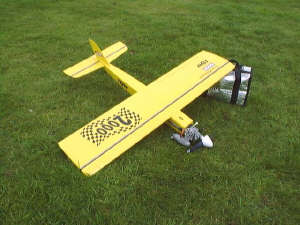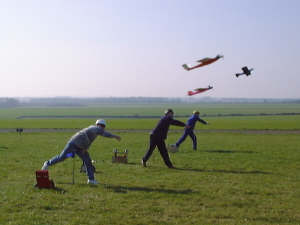

| Let's Go Racing (On a Budget) |
Identify your models please. What frequency are you on? Switch on and check your radios. Is everyone happy? You have one minute to start and set up your engines, if you have all started we will start the race early. There then follows some frantic flicking of propellers, although some use electric starters, an en masse hand launch of up to four models which then proceed down to number one pylon whereupon four callers shout turn!! The race is on and the screaming of the little .25 engines and the shouts of "turn" continues for a total of ten laps of the race course before peace and tranquillity are restored again. The whole process, from launch to finish, having taken less than 90 seconds. This is the world of the Club 2000 pylon racer.
 What
is Pylon Racing?
What
is Pylon Racing?
Apart from being an enjoyable way of spending a Sunday, pylon racing is
the modelling version of full size, closed circuit, air racing. Up to
4 models fly ten laps of a triangular course. Depending on the class that
is raced, the course will be a length of 400 mtrs for F3D, Sport 40 and
Club 40 or 880ft for Club 2000.
In The Beginning
Many years ago, during the mid 70's when I was but a lad, I remember the
introduction of Club 20 pylon racing. The idea was to introduce model
flyers to the thrills and spills of racing without breaking the bank.
The models were simple affairs built to a set of rules and powered by
a budget .20 sized engine. All was well until the competitive edge took
over, exotic and expensive engines were introduced in to the class that
led to increased speeds which in turn led to more sophisticated airframes.
The vicious circle of the quest for performance had started and it wasn't
long until these little models were turning in an average speed of well
over 100mph for the course. Not surprisingly the class took a nosedive
and people left the class put off by the rising costs. No newcomers joined
the class as they too were put off by the expense and the frightening
performance of the models.
And Then...
After 20 something years it was decided that if a cheap form racing was
to continue then radical changes had to be made and it was during the
closed season of 1999 that the experts got their heads together and the
Club 2000 class was born. Out went exotic materials, out went expensive
engines and in came a sensible class, with easy to build airframes, to
be powered by inexpensive .25 sized engines. This time round there was
an air of determination that flying skill and not bank balance would rule
the day.
Let's Find Out More
I enjoy various forms of racing and have always had a desire to go pylon
racing but circumstances had perpetually contrived to prevent me doing
so. That was until 2002. Having come back to the hobby after a fifteen
year absence I had already decided that an attempt at racing was on the
cards, problem was what class? In an attempt to find out I attended a
meeting at RAF Cottesmore where I observed three classes of racing, F3D,
Sport .40 and Quickie 500. F3D was like formula 1 car racing and it would
have been foolhardy to have attempted this class. Sport .40 also looked
very impressive and not too far behind F3D. The Quickie 500 class boasted
only two entries, which crashed into each other in a spectacular mid air.
The one thing that stood out at this meeting was the high level of noise
which meant that any practicing, which I felt would be essential to guarantee
any sort of success, would be confined to organised practice days and
race meetings. In this day and age none of these models would be made
welcome at your local flying field. November 2002 saw me arrive at a Club
2000 meeting being held near Northampton. This looked more like it, models
with a sprightly performance that would be simple to build. Being powered
by standard engines turning a sensible sized propeller they were also
well within the 82db BMFA noise limit and could be flown at any club field.
 The
Organisation
The
Organisation
Club 2000 is governed and organised by a committee of seasoned racers.
Graham Clarke, who himself can boast 27 years in the sport, is the Contest
Director who receives the entries and organises the events of race day.
Most of the race meetings take place, on the first Sunday of each month,
at a site just outside Northampton.
Race Day
Race day normally starts with most competitors arriving at around 9 o'
clock. The first job is to erect the course, a bit of a chore that is
made a lot easier by the involvement of all the competitors. Once the
course has been erected a few test flights can be made, at the discretion
of the Competition Director.
Racing commences with everyone competing in a series of qualifying heats,
6 heats are normally run during the course of a day with the best 4 times
counting towards your overall placing, it's all about consistency this
game. Pilot ability is split into Groups 1, 2 and 3. Group 1 being the
very best flyers and Group 3 being where everyone starts. All groups have
their own finals for which trophies and prizes are awarded. Thanks to
the efforts of Graham and the attitude of the competitors these race days
are quite laid back affairs and not the cut and thrust events that you
might expect.
Hardware
The rules governing the construction of the models are so simple that
you could design your own model, if that is not to your liking then Modelcraft
of Coventry can supply a suitable kit called the Freedom 2000 which is
available with a built up or fibreglass fuselage. Indeed this model powered
by the Irvine .25 is the favoured combination of most racers. If you really
don't like building then the staff at Modelcraft, in Coventry, can sometimes
build the model for you.
Lets do it
Having decided that this is the discipline for you, where do you go from
here? I would suggest that you contact one of the people listed below
who will be able to tell you how best to proceed from here. Take time
to check out the excellent website at www.ukpylon.co.uk where you will
find a wealth of information including the rules and regulations. All
races are held at a venue near Northampton. Why not come along and have
a look.
Contacts:
Frank Fletcher Club 2000 Chairman 01939 233712
Graham Clarke Contest Director 02476 4211124
This page has been contributed by UK Pylon Racing